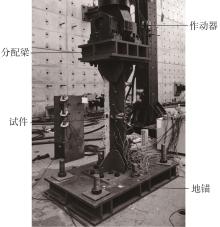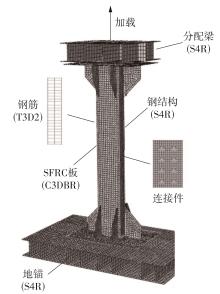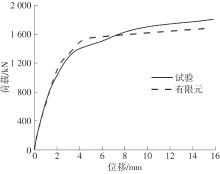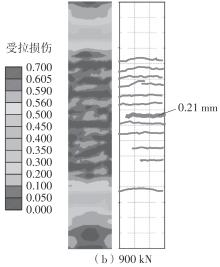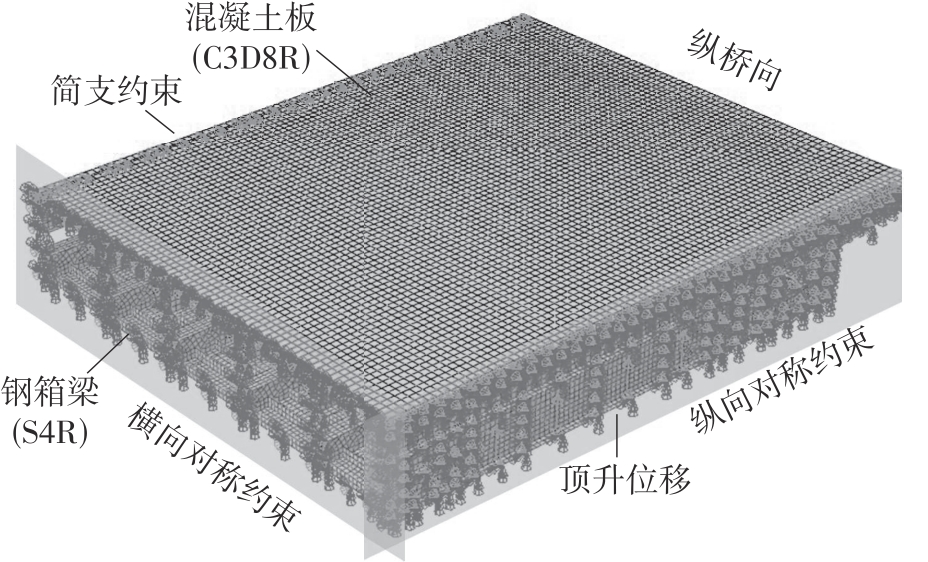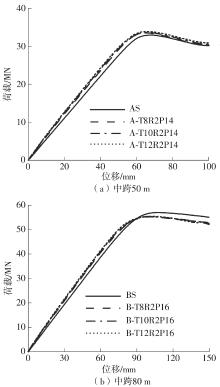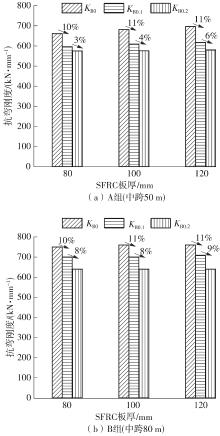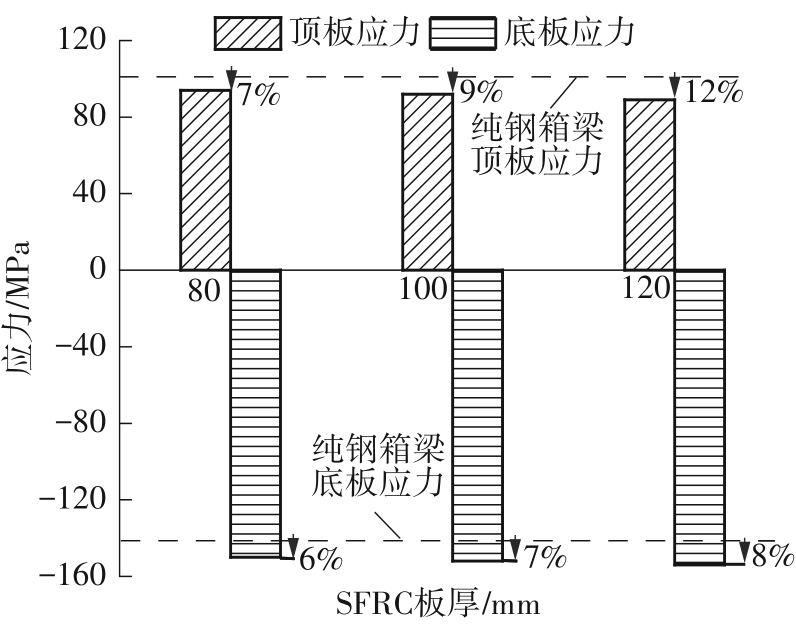Journal of South China University of Technology(Natural Science Edition) ›› 2024, Vol. 52 ›› Issue (1): 26-37.doi: 10.12141/j.issn.1000-565X.220840
• Structural Fatigue and Damage • Previous Articles Next Articles
Optimal Design of Steel-SFRC Composite Deck of Continuous Steel Girder
XU Chen1 XU Qindong1 SUN Xuxia2 WU Yongxian2 ZHANG Yubin3 XU Yi1
- 1.College of Civil Engineering,Tongji University,Shanghai 200092,China
2.Tongji Architectural Design (Group) Co. ,Ltd. ,Shanghai 200092,China
3.Xingtai Construction Group Co. ,Ltd. ,Hohhot 010000,Inner Mongolia,China
-
Received:2022-12-31Online:2024-01-25Published:2023-06-07 -
About author:徐晨(1982-),男,博士,副教授,博士生导师,主要从事组合结构桥梁研究。E-mail:xuchenprc@tongji.edu.cn
CLC Number:
Cite this article
XU Chen, XU Qindong, SUN Xuxia, et al.. Optimal Design of Steel-SFRC Composite Deck of Continuous Steel Girder[J]. Journal of South China University of Technology(Natural Science Edition), 2024, 52(1): 26-37.
share this article
Table 1
FE model parameters of girder segment"
| 组别 | 模型编号 | SFRC板厚/mm | 配筋率/ % | 钢顶板厚/mm |
|---|---|---|---|---|
A (中跨50 m) | AS | 0 | 0 | 14 |
| A-T8R2P14 (T10,T12) | 80(100,120) | 2 | 14 | |
| A-T10R1P14(R3) | 100 | 1(3) | 14 | |
| A-T8R2P10(P12) | 80 | 2 | 10(12) | |
| A-T10R2P10(P12) | 100 | 2 | 10(12) | |
| A-T12R2P10(P12) | 120 | 2 | 10(12) | |
B (中跨80 m) | BS | 0 | 0 | 16 |
| B-T8R2P14 (T10,T12) | 80(100,120) | 2 | 16 | |
| B-T10R1P16(R3) | 100 | 1(3) | 16 | |
| B-T8R2P12(P14) | 80 | 2 | 12(14) | |
| B-T10R2P12(P14) | 100 | 2 | 12(14) | |
| B-T12R2P14(P14) | 120 | 2 | 12(14) |
Table 2
Bending stiffness of finite element models with different SFRC slab thicknesses"
| 模型编号 | KB0 / (kN·mm-1) | KB0.1/ (kN·mm-1) | KB0.2 / (kN·mm-1) | 增长率/% |
|---|---|---|---|---|
| AS | 561 | 555 | 549 | |
| A-T8R2P14 | 661 | 596 | 575 | 17.8 |
| A-T10R2P14 | 681 | 609 | 576 | 21.3 |
| A-T12R2P14 | 696 | 617 | 580 | 24.1 |
| BS | 658 | 648 | 626 | |
| B-T8R2P16 | 772 | 691 | 635 | 17.3 |
| B-T10R2P16 | 789 | 702 | 636 | 19.9 |
| B-T12R2P16 | 801 | 711 | 640 | 21.7 |
Table 6
Summary of partial optimization variable combinations"
| 方案编号 | 混凝土板厚/mm | 配筋率/% | 顶板/mm | 底板2/mm | 底板3/mm | 纵肋厚/mm | 纵肋高/mm | 材料成本/ (元·m-2) |
|---|---|---|---|---|---|---|---|---|
| A-T10R1P14J16* | 100 | 1 | 14 | 20 | 16 | 16 | 190 | 6 833 |
| AO-T8R1P12J10 | 80 | 1 | 12 | 20 | 20 | 10 | 120 | 5 821 |
| AO-T8R2P12J10 | 80 | 2 | 12 | 20 | 20 | 10 | 120 | 5894 |
| AO-T8R3P12J10 | 80 | 3 | 12 | 20 | 20 | 10 | 120 | 5 972 |
| B-T10R1P16J16* | 100 | 1 | 16 | 28 | 24 | 16 | 190 | 8 170 |
| BO-T8R1P14J10 | 80 | 1 | 14 | 28 | 28 | 10 | 120 | 7 163 |
| BO-T8R2P14J10 | 80 | 2 | 14 | 28 | 28 | 10 | 120 | 7 237 |
| BO-T9R3P14J10 | 90 | 3 | 14 | 28 | 28 | 10 | 120 | 7436 |
Table 8
Comparison of the stress of the steel structure between the original design and the optimization scheme under the basic combination effect"
| 中跨跨径/m | 结果类别 | 顶板应力/MPa | 底板应力/MPa | 变化率/% | ||||
|---|---|---|---|---|---|---|---|---|
| 中支点截面 | 跨中截面 | 中支点截面 | 跨中截面 | 用钢量 | 上部结构重 | 材料成本 | ||
| 50 | 原设计 | 121 | -89 | -146 | 182 | |||
| 优化结果 | 92 | -79 | -163 | 169 | -13 | -12 | -14 | |
| 80 | 原设计 | 148 | -109 | -170 | 173 | |||
| 优化结果 | 128 | -98 | -192 | 172 | -6 | -6 | -9 | |
| 1 | 张清华,卜一之,李乔 .正交异性钢桥面板疲劳问题的研究进展[J].中国公路学报,2017,30(3):14-30,39. |
| ZHANG Qing-hua, BU Yi-zhi, LI Qiao .Review of fatigue problems of orthotropic steel bridge deck[J].China Journal of Highway and Transport,2017,30(3):14-30,39. | |
| 2 | 邵旭东,曹君辉,易笃韬,等 .正交异性钢板-薄层RPC组合桥面基本性能研究[J].中国公路学报,2012,25(2):40-45. |
| SHAO Xudong, CAO Junhui, YI Dutao,et al .Research on basic performance of composite bridge deck system with orthotropic steel deck and thin RPC Layer[J].China Journal of Highway and Transport,2012,25(2):40-45. | |
| 3 | 曾明根,武彧,苏庆田 .钢纤维混凝土组合桥面板负弯矩区开裂性能试验[J].吉林大学学报(工学版),2023,53(11):3176-3185. |
| ZENG Minggen, WU Yu, SU Qingtian .Experimental studies on cracking behavior of steel fiber reinforced concrete slab in negative moment region of orthotropic composite bridge deck[J].Journal of Jilin University(Engineering and Technology Edition),2023,53(11):3176-3185. | |
| 4 | YE Huawen, YANG Zhe, HAN Bing,et al .Failure mechanisms governing fatigue strength of steel-SFRC composite bridge deck with u-ribs[J].Journal of Bridge Engineering,2021,26(4):04021014/1-9. |
| 5 | 李文光,邵旭东,方恒,等 .钢-UHPC组合板受弯性能的试验研究[J].土木工程学报,2015,48(11):93-102. |
| LI Wenguang, SHAO Xudong, FANG Heng,et al .Experimental study on flexural behavior of steel-UHPC composite slabs[J].China Civil Engineering Journal,2015,48(11):93-102. | |
| 6 | LUO Jun, SHAO Xudong, CAO Junhui,et al .Transverse bending behavior of the steel-UHPC lightweight composite deck:orthogonal test and analysis[J].Journal of Constructional Steel Research,2019,162:105708/1-19. |
| 7 | LUO Jun, SHAO Xudong, FAN Wei,et al .Flexural cracking behavior and crack width predictions of composite (steel+UHPC) lightweight deck system[J].Engineering Structures,2019,194:120-137. |
| 8 | 张清华,程震宇,廖贵星,等 .波形顶板-UHPC组合桥面板优化设计[J].西南交通大学学报,2018,53(4):670-678. |
| ZHANG Qinghua, CHENG Zhenyu, LIAO Guixing,et al .Optimal design of corrugated steel deck plate-UHPC layer composite deck[J].Journal of Southwest Jiaotong University,2018,53(4):670-678. | |
| 9 | 孙瑜,王焕然,王飞,等 .波形钢板-UHPC组合桥面板结构截面优化[J].宁波大学学报(理工版),2020,33(3):105-110. |
| SUN Yu, WANG Huanran, WANG Fei,et al .Section optimization of the innovative corrugated steel-UHPC composite bridge deck[J].Journal of Ningbo University (Natural Science & Engineering Edition),2020,33(3):105-110. | |
| 10 | 活性粉末混凝土: [S]. |
| 11 | 金属材料室温拉伸试验方法: [S]. |
| 12 | 单波 .活性粉末混凝土基本力学性能的试验与研究[D].长沙:湖南大学,2002. |
| 13 | LEE J, FENVES G L .Plastic-damage model for cyclic loading of concrete structures[J].Journal of Engineering Mechanics,1998,124(8):892-900. |
| 14 | 田连波,侯建国 .ABAQUS中混凝土塑性损伤因子的合理取值研究[J].湖北大学学报(自然科学版),2015,37(4):340-345,358. |
| TIAN Lianbo, HOU Jianguo .Reasonable plastic da-maged factor of concrete damaged plastic model of ABAQUS[J].Journal of Hubei University (Natural Science),2015,37(4):340-345,358. | |
| 15 | 袁晓燕 .波形钢腹板PC组合箱梁桥与PC连续箱梁桥的结构分析与经济比较[D].南京:东南大学,2015. |
| 16 | 公路桥涵设计通用规范: [S]. |
| 17 | 史占崇,苏庆田,邵长宇,等 .粗骨料UHPC的基本力学性能及弯曲韧性评价方法[J].土木工程学报,2020,53(12):86-97. |
| SHI Zhanchong, SU Qingtian, SHAO Changyu,et al .Basic mechanical behavior and flexural toughness evaluation method of coarse aggregate UHPC[J].China Civil Engineering Journal,2020,53(12):86-97. | |
| 18 | 公路钢筋混凝土及预应力混凝土桥涵设计规范: [S]. |
| 19 | 公路钢混组合桥梁设计与施工规范: [S]. |
| 20 | 钢纤维混凝土结构设计标准: [S]. |
| [1] | XU Wen-dong CHEN Zhong LI Xia-xi XING Lin-lin QIAN Di QIN Zhen. An Integrated Process of Using Pressure Energy of Natural Gas to Generate Electricity and Produce Dry Ice [J]. Journal of South China University of Technology (Natural Science Edition), 2016, 44(11): 41-48. |
| [2] | Tian Ti-xian Jiang Hong-zhou He Jing-feng Tong Zhi-zhong Huang Qi-tao. Optimal Design of Generalized Stewart Platform with Global Dynamic Isotropy Based on a Pair of Circular Hyperboloid of one Sheet [J]. Journal of South China University of Technology (Natural Science Edition), 2015, 43(2): 120-126. |
| [3] | Chen Zhou Yan Quan- sheng Hu Jun- liang Huang Shi- ping Yu Xiao- lin. Coupling Vibration Investigation and Parameter Analysis of Crowd- Bridge System [J]. Journal of South China University of Technology (Natural Science Edition), 2014, 42(5): 75-83. |
| [4] | Chen Jin Guo Xiao-feng Li Song-lin Sun Zhen-ye. Structural Optimization of Pre-Bending Wind Turbine Blade Based on Parametric Modeling [J]. Journal of South China University of Technology (Natural Science Edition), 2014, 42(12): 90-96,111. |
| [5] | Zhang Hua- wei Xia Wei Wu Zhi- heng Chen Min Jing You- yan Zhang Xin- hua. Optimal Design of Clamping Device of Large Die- Casting Machine Based on Numerical Simulation [J]. Journal of South China University of Technology (Natural Science Edition), 2013, 41(9): 113-119. |
| [6] | Xu Yan Tan Jian- ping Wang Jun- feng Liu Yun- long Zhu Zhong- yan. Temperature Rise of Electromagnet of Large- Gap Magnetic Drive System [J]. Journal of South China University of Technology (Natural Science Edition), 2013, 41(11): 109-113. |
| [7] | Deng Xian-he Jiang Fu-hua . Analyses of Flow Path in Shell Side of Heat Exchangers and Heat Transfer Deviation of Baffling Flow from Counterflow [J]. Journal of South China University of Technology (Natural Science Edition), 2010, 38(8): 12-16,22. |
| [8] | Yang Chun Wu Yi Cai Jian Chen Qing-jun Su Guo-wei. Parameter Analysis for Mechanical Properties of Steel-Reinforced Concrete Transfer Girders with Inner Steel Truss [J]. Journal of South China University of Technology (Natural Science Edition), 2008, 36(12): 28-33. |
| [9] | Luo Guan-yong Cao Ho Pan Hong Zhou Hong-xing. Optimal Design and M onitoring of Steel Sheet Pile Coferdams of Xinguang Bridge [J]. Journal of South China University of Technology (Natural Science Edition), 2006, 34(2): 124-129. |
| Viewed | ||||||
|
Full text |
|
|||||
|
Abstract |
|
|||||


